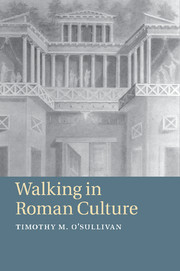Book contents
- Frontmatter
- Contents
- Figures
- Acknowledgements
- Abbreviations
- Introduction
- Chapter 1 The art of walking
- Chapter 2 Seneca on the mind in motion
- Chapter 3 Urban walkers on display
- Chapter 4 Cicero’s legs
- Chapter 5 Theoretical travels
- Chapter 6 Walking with Odysseus
- Conclusion
- Bibliography
- Subject index
- Index locorum
Chapter 2 - Seneca on the mind in motion
Published online by Cambridge University Press: 05 August 2011
- Frontmatter
- Contents
- Figures
- Acknowledgements
- Abbreviations
- Introduction
- Chapter 1 The art of walking
- Chapter 2 Seneca on the mind in motion
- Chapter 3 Urban walkers on display
- Chapter 4 Cicero’s legs
- Chapter 5 Theoretical travels
- Chapter 6 Walking with Odysseus
- Conclusion
- Bibliography
- Subject index
- Index locorum
Summary
In a well-known letter to Lucilius about the unity of rhetorical style and personal attributes, the younger Seneca argues that mind, body, and literary style are all interconnected (Ep. 114.3):
non potest alius esse ingenio, alius animo color. si ille sanus est, si compositus, gravis, temperans, ingenium quoque siccum ac sobrium est: illo vitiato hoc quoque adflatur. non vides, si animus elanguit, trahi membra et pigre moveri pedes? si ille effeminatus est, in ipso incessu apparere mollitiam? si ille acer est et ferox, concitari gradum? si furit aut, quod furori simile est, irascitur, turbatum esse corporis motum nec ire sed ferri? quanto hoc magis accidere ingenio putas, quod totum animo permixtum est, ab illo fingitur, illi paret, inde legem petit?
It is not possible for someone’s literary style to be colored one way, and his mind a different way. If the mind is healthy, well ordered, serious, and moderate, then the style is also dry and sober. If the mind is tainted, then the style is also infected. If someone’s mind lacks vigor, don’t you see how his limbs drag and his feet move lazily? If his mind is effeminate, how its softness shows up in his very gait? If it is passionate and headstrong, how his steps are quick? If his mind is insane or angry (which is just like being insane), don’t you see how his body’s movement is agitated, how he does not move but rather is carried along? So don’t you think this is even more true of his style, since it is entirely intermingled with his mind, since it is shaped by his mind, obeys it, gets its rules from it?
- Type
- Chapter
- Information
- Walking in Roman Culture , pp. 34 - 50Publisher: Cambridge University PressPrint publication year: 2011



